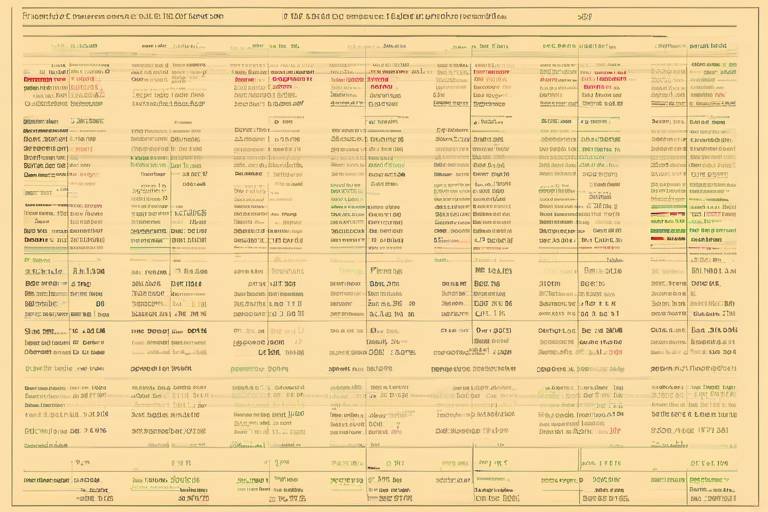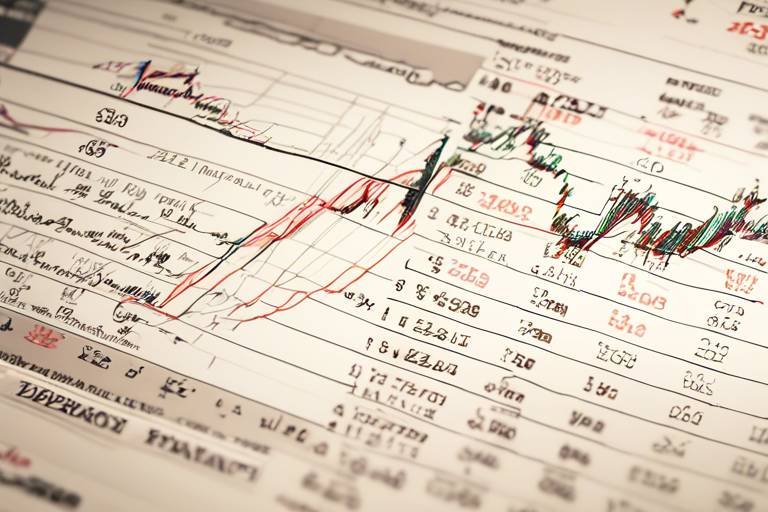Understanding the Role of Support and Resistance in Trading
In the dynamic world of trading, understanding the concepts of support and resistance is crucial for anyone looking to navigate the financial markets successfully. These levels are not just mere numbers on a chart; they represent the emotional battleground between buyers and sellers. As traders, we often find ourselves asking, "Where should I enter the market?" or "When is the right time to exit?" The answers often lie in the intricate dance of support and resistance levels. By mastering these concepts, you can significantly enhance your trading strategies, make better decisions, and ultimately improve your profitability.
Support is essentially a price point on a chart where the demand for an asset is strong enough to prevent the price from falling further. Imagine it as a safety net that catches a falling object. When the price approaches this level, traders expect buying interest to emerge, leading to a potential reversal or pause in the downtrend. Identifying support can be a game-changer for traders seeking to capitalize on potential buy opportunities. For instance, if a stock has consistently bounced back from a price of $50, this level becomes a significant support level. Knowing this can help traders position themselves to buy when the price approaches this level again.
On the flip side, resistance refers to a price level at which selling interest is strong enough to prevent the price from rising further. Think of it as a ceiling that limits how high a price can go. When the price reaches this level, traders often see it as a prime opportunity to sell, anticipating that the price will either stall or reverse. Recognizing resistance levels is essential for traders looking to find sell opportunities. For example, if a stock has repeatedly failed to break through the $100 mark, this level serves as a psychological barrier, making it a critical resistance point to watch.
The concepts of support and resistance are deeply rooted in market psychology. Each level represents the collective emotions and behaviors of traders. When prices approach support, buyers feel a sense of urgency to purchase, believing they are getting a good deal. Conversely, at resistance, sellers feel compelled to act, fearing they might miss out on profits. This tug-of-war between buyers and sellers creates a fascinating dynamic that influences price movements. Understanding this psychology can empower traders to anticipate market reactions more accurately.
Market sentiment is a powerful force in establishing support and resistance levels. It reflects the overall attitude of traders towards a particular asset. When sentiment is bullish, support levels may hold firm, while bearish sentiment can lead to breaches of these levels. For instance, during a market downturn, even strong support levels can be shattered if the sentiment is overwhelmingly negative. This is why keeping an eye on news, economic indicators, and trader sentiment is vital for effective trading.
Analyzing historical price action is another effective way to identify support and resistance levels. By looking at past price movements, traders can see how these levels have functioned over time. For example, if a stock has bounced off a particular price multiple times in the past, it's likely that this level will continue to act as support in the future. Historical data serves as a guide, helping traders make informed predictions about future price movements.
There are several methods traders can use to identify support and resistance levels. Here are a few common techniques:
- Trend Lines: Drawing trend lines on a chart can help visualize support and resistance levels based on price trends.
- Moving Averages: These can act as dynamic support and resistance levels, adjusting as prices change.
- Chart Patterns: Recognizing patterns like head and shoulders or double tops can provide insights into potential support and resistance levels.
Each method offers unique insights, and traders often combine them for a more comprehensive analysis of market behavior.
Incorporating support and resistance levels into your trading strategies can significantly enhance your entry and exit points. By doing so, you not only improve your overall trading performance but also bolster your risk management strategies. For instance, entering a trade near a support level can minimize potential losses, while exiting near a resistance level can secure profits effectively.
One of the most effective ways to manage risk is by strategically placing stop-loss and take-profit orders around support and resistance levels. A stop-loss order placed just below a support level can help minimize losses if the price breaks through. Conversely, a take-profit order set just below a resistance level can lock in profits before a potential reversal occurs. This method not only protects your capital but also allows you to trade with more confidence.
Integrating support and resistance levels with technical indicators can provide a more comprehensive analysis of market conditions. Indicators like the Relative Strength Index (RSI) or Moving Average Convergence Divergence (MACD) can help confirm whether a price is likely to bounce off support or reverse at resistance. By combining these tools, traders can make more informed decisions, improving their overall trading outcomes.
1. What is the best way to identify support and resistance levels?
Traders can use various methods such as trend lines, moving averages, and historical price action to identify key support and resistance levels.
2. Can support and resistance levels change?
Yes, support and resistance levels can change based on market conditions, trader sentiment, and new price data.
3. How should I use support and resistance in my trading strategy?
Incorporate support and resistance levels to determine entry and exit points, and use them to set stop-loss and take-profit orders for effective risk management.

What is Support?
Support is a crucial concept in trading that refers to a specific price level where a downward trend tends to pause or reverse due to a significant concentration of demand. Imagine a trampoline: when you jump down, the fabric stretches, but it eventually pushes you back up. Similarly, when the price of an asset falls to a support level, it often bounces back up as buyers step in, believing that the asset is undervalued at that point. Understanding support can help traders identify potential buying opportunities, allowing them to capitalize on price rebounds.
When traders recognize support levels, they often look for signs that the price will not fall below that level. This psychological barrier can be attributed to several factors:
- Market Sentiment: Traders often feel more confident buying at lower prices, leading to increased demand.
- Historical Price Action: If a stock has previously bounced off a certain price point, traders may anticipate a similar reaction in the future.
- Volume Indicators: High trading volume at a support level can indicate strong buying interest, reinforcing the likelihood of a price rebound.
It's essential to note that support levels are not always absolute. They can be tested multiple times and may eventually break, leading to new price levels. This phenomenon is akin to a dam holding back water; if the pressure becomes too great, the dam may fail, resulting in a significant price drop. Therefore, traders should remain vigilant and consider other factors that may influence price movements.
To better understand support levels, let's take a look at a simple table illustrating some examples:
| Asset | Support Level | Previous Bounce |
|---|---|---|
| Stock A | $50 | Yes |
| Stock B | $30 | No |
| Stock C | $75 | Yes |
In summary, support levels are vital for traders aiming to make informed decisions. By recognizing these levels, traders can better position themselves to take advantage of market dynamics. Understanding the interplay of demand and price action at these levels is fundamental to developing effective trading strategies.

What is Resistance?
Resistance is a fundamental concept in trading that refers to a specific price level where an upward trend can be expected to pause or reverse due to a significant concentration of selling interest. Think of it as a ceiling that prices struggle to break through. When traders see prices approaching a resistance level, they often anticipate that the upward momentum will stall, leading to potential selling opportunities. This behavior is largely driven by market psychology, as many traders remember past instances where prices have failed to exceed certain levels, reinforcing their belief that a similar outcome is likely to occur again.
Understanding resistance is crucial for traders looking to maximize their profits while minimizing risks. When a price reaches a resistance level, traders may either choose to sell their positions or place new short orders, betting that the price will not surpass that level. This creates a self-fulfilling prophecy, where the actions of traders contribute to the resistance itself. The more traders recognize and act upon a resistance level, the stronger that resistance becomes.
Resistance levels can be identified through various methods, including:
- Historical Price Levels: Previous high points in the price action often serve as resistance levels for future movements.
- Trend Lines: Drawing lines along the peaks of price movements can help visualize potential resistance levels.
- Moving Averages: Common moving averages, such as the 50-day or 200-day, can act as dynamic resistance levels.
It's important to note that resistance is not a fixed barrier; it can change over time as market conditions evolve. When prices do break through a resistance level, it can indicate a strong bullish sentiment, often leading to further price increases as traders adjust their strategies. This phenomenon is often referred to as "breaking resistance," and it can provide lucrative opportunities for traders who are quick to react.
In summary, resistance is a vital aspect of market analysis that traders must understand to navigate the complexities of trading effectively. By recognizing where resistance levels lie, traders can make more informed decisions about when to enter or exit trades, ultimately enhancing their trading strategies and potential profitability.
Q: How can I identify resistance levels in a stock chart?
A: You can identify resistance levels by looking for previous high points in the price action, using trend lines, or applying moving averages. Observing where prices have historically struggled to rise can also provide insights into potential resistance levels.
Q: What happens if a resistance level is broken?
A: If a resistance level is broken, it may indicate a strong bullish trend, and prices could continue to rise. Traders often look for confirmation of this breakout before entering new positions.
Q: Can resistance levels change over time?
A: Yes, resistance levels can change as market dynamics evolve. New highs or changes in market sentiment can lead to the establishment of new resistance levels.

The Psychology Behind Support and Resistance
The concepts of support and resistance are more than just lines on a chart; they are deeply rooted in the psychology of traders. Imagine a bustling marketplace where buyers and sellers negotiate prices. Just like in that market, traders react to price levels based on their emotions, experiences, and expectations. When prices drop to a certain level, buyers often step in, believing it’s a bargain—this creates a support level. Conversely, when prices rise to a point where sellers think they can cash in on their investments, that creates a resistance level.
Understanding this psychological dynamic is crucial for traders. At support levels, a sense of optimism prevails among buyers, who see the potential for prices to rebound. This optimism can lead to increased buying activity, reinforcing the support level. On the flip side, at resistance levels, sellers feel a wave of confidence and are often quick to sell, anticipating that prices will not go higher. This confidence can lead to increased selling pressure, further solidifying the resistance level.
To illustrate how psychology plays a role in trading, consider the following factors:
- Fear and Greed: These two emotions are the driving forces in trading. Fear can prevent traders from buying at support, while greed can lead to overzealous selling at resistance.
- Market Sentiment: The collective mood of traders can shift rapidly, impacting how they react to price levels. A bullish sentiment can strengthen support, while bearish sentiment can weaken it.
- Confirmation Bias: Traders often look for information that confirms their existing beliefs. If a trader believes a stock is undervalued, they might see a support level as a clear buying opportunity, ignoring any contrary signals.
These psychological factors create a self-fulfilling prophecy. As more traders recognize and react to support and resistance levels, these levels become more entrenched in the market. This is why it's essential for traders to not only analyze charts but also to understand the emotional landscape of the market. It’s like being a psychologist and a trader at the same time—understanding the motivations behind market movements can give you a significant edge.
Furthermore, the interplay between support and resistance levels can lead to dramatic market movements. For example, if a stock breaks through a resistance level, it can trigger a rush of buying as traders jump on the bandwagon, believing that the price will continue to rise. This phenomenon is often referred to as a breakout. Conversely, if a support level is breached, it can lead to panic selling, as traders rush to cut their losses, leading to a further decline in price.
In summary, the psychology behind support and resistance is a fascinating blend of emotions, behaviors, and market sentiment. By understanding these psychological factors, traders can better navigate the complexities of the market and make more informed decisions. It's not just about numbers and charts; it's about the human element that drives those numbers. So, the next time you're analyzing a chart, take a moment to consider the psychology at play. It might just give you the insight you need to make your next big trading decision.
Q: What are support and resistance levels?
A: Support levels are price points where buying interest is strong enough to overcome selling pressure, while resistance levels are where selling interest outweighs buying pressure.
Q: How can I identify support and resistance levels?
A: You can identify these levels using various methods such as trend lines, historical price action, moving averages, and chart patterns.
Q: Why are support and resistance important in trading?
A: They help traders make informed decisions on when to enter or exit trades, manage risk, and improve overall trading performance.

Market Sentiment and Its Impact
Market sentiment is like the pulse of the trading world; it reflects the collective emotions and attitudes of traders towards a particular asset or market. Just as the weather can change from sunny to stormy in an instant, market sentiment can shift rapidly, impacting price movements significantly. When traders feel optimistic, they are more likely to buy, pushing prices up. Conversely, during periods of fear or uncertainty, traders tend to sell, leading to price declines. Understanding this sentiment is crucial for traders looking to navigate the often turbulent waters of the financial markets.
One way to gauge market sentiment is through various indicators and tools. For instance, the Fear and Greed Index provides insight into whether investors are feeling fearful or greedy, which can be a powerful signal for potential price movements. Additionally, social media platforms and financial news outlets can serve as barometers for public sentiment, often revealing how traders are feeling about specific stocks or the market as a whole.
Furthermore, market sentiment can create self-fulfilling prophecies. If a large number of traders believe that a stock is going to rise, their buying activity can indeed drive the price up, validating their initial belief. This phenomenon can create significant support levels as traders flock to buy at perceived low prices, reinforcing the notion that these levels are reliable indicators of where the market might turn. On the flip side, if the sentiment turns negative, resistance levels can be established as traders rush to sell, fearing further declines.
Understanding the interplay between support, resistance, and market sentiment can empower traders to make more informed decisions. By recognizing how emotional factors influence trading behavior, traders can better anticipate price movements and adjust their strategies accordingly. For instance, if a trader identifies a strong support level coinciding with positive market sentiment, it might be an opportune moment to enter a long position. Conversely, if resistance levels are being tested amid negative sentiment, it may be wise to consider shorting the asset.
In summary, market sentiment is a powerful force in the trading landscape. By keeping a finger on the pulse of trader emotions, individuals can enhance their trading strategies, improve decision-making, and ultimately, increase their chances of success in the market.
- What is market sentiment? Market sentiment refers to the overall attitude of traders towards a particular security or market, influenced by psychological factors and collective emotions.
- How can I measure market sentiment? Market sentiment can be gauged through various indicators, social media trends, news articles, and tools like the Fear and Greed Index.
- Why is market sentiment important in trading? Understanding market sentiment helps traders anticipate price movements, allowing them to make more informed decisions regarding buying or selling assets.

Historical Price Action
Understanding is like peering into the past to predict the future. Just as a detective examines clues left behind at a crime scene, traders analyze patterns in historical price movements to identify potential support and resistance levels. These levels are not just arbitrary lines on a chart; they represent moments where traders have previously made significant decisions, leading to price reversals or continuations.
When we look back at historical price action, we can see how certain price levels have acted as barriers in the past. For instance, if a stock repeatedly bounces off a specific price point, that level is likely to be a strong support zone. Conversely, if the price consistently fails to break through a certain threshold, that area becomes a key resistance level. This repetitive behavior is often driven by trader psychology, where the collective memory of past trades influences future actions.
To effectively analyze historical price action, traders often rely on various tools and techniques. One popular method is the use of candlestick charts, which provide visual representations of price movements over specific time frames. By studying the shapes and patterns of candlesticks, traders can glean insights into market sentiment and potential turning points. For example, a series of bullish candlesticks at a support level could signal a strong buying interest, while bearish candlesticks at a resistance level might indicate selling pressure.
Another effective approach is the use of moving averages. These indicators smooth out price data over a specified period, allowing traders to identify trends and potential reversal points. For instance, a 50-day moving average that aligns with a historical support level can reinforce the significance of that price point, making it a critical area for traders to watch.
Moreover, traders can also utilize Fibonacci retracement levels to identify potential support and resistance zones. By taking key price points and applying Fibonacci ratios, traders can uncover hidden levels that may not be immediately apparent through traditional analysis. These levels often coincide with historical price action, providing additional validation for traders' strategies.
In conclusion, the study of historical price action is essential for any trader looking to enhance their trading strategies. By understanding how prices have reacted at certain levels in the past, traders can make more informed decisions and improve their chances of success in the ever-changing market landscape.
- What is historical price action? Historical price action refers to the analysis of past price movements to identify patterns and levels of support and resistance.
- How can I use historical price action in trading? Traders can use historical price action to identify potential buy and sell opportunities by recognizing key support and resistance levels.
- What tools can help analyze historical price action? Tools such as candlestick charts, moving averages, and Fibonacci retracement levels are commonly used to analyze historical price action.
- Why is understanding historical price action important? It helps traders predict future price movements based on past behaviors, improving decision-making and trading strategies.

Identifying Support and Resistance Levels
Identifying support and resistance levels is crucial for any trader looking to navigate the often turbulent waters of the financial markets. These levels are not just arbitrary numbers; they represent key psychological thresholds where traders collectively decide to buy or sell. Think of them as the invisible walls that can either propel prices higher or send them tumbling down. So, how do traders pinpoint these important levels? There are several methods that can be employed, and each offers its unique perspective on market behavior.
One of the most straightforward ways to identify support and resistance is through the use of trend lines. By connecting the lows in a downtrend or the highs in an uptrend, traders can visually map out these critical levels. A trend line acts like a guide, helping traders see where the price has historically reacted. When the price approaches these lines, it often leads to a pause or reversal, making them valuable for planning trades.
Another popular method is the use of moving averages. These averages smooth out price data over a specific period, allowing traders to see the overall trend more clearly. For example, the 50-day or 200-day moving averages are commonly watched by traders. When the price approaches these moving averages, they can act as dynamic support or resistance levels. Imagine moving averages as the market’s safety net; they help traders gauge whether the price is likely to bounce back or break through.
Chart patterns also play a significant role in identifying support and resistance levels. Patterns such as head and shoulders, double tops, and triangles can provide insights into potential price reversals. For instance, a double top pattern indicates that the price has hit a resistance level twice and is likely to reverse. Recognizing these patterns can be a game-changer for traders, as they give clues about where the market might head next.
To make it easier for traders, here’s a quick summary of some methods for identifying support and resistance:
- Trend Lines: Connect the highs or lows to visualize potential levels.
- Moving Averages: Use averages like the 50-day or 200-day to see dynamic support/resistance.
- Chart Patterns: Look for formations like head and shoulders, double tops, or triangles.
Moreover, it's essential to consider the volume at these levels. High trading volume near support or resistance can indicate a strong conviction among traders, making these levels even more significant. When a price level is approached with heavy volume, it’s often a signal that traders are either entering or exiting positions, further solidifying the importance of that level.
Lastly, don't forget to analyze historical price action. By looking back at past price movements, traders can see how often a specific level has been tested. The more times a support or resistance level has been touched without being broken, the more reliable it becomes. It’s like building a reputation; the more times a level proves itself, the more traders will pay attention to it in the future.
In summary, identifying support and resistance levels is not merely an exercise in technical analysis; it’s about understanding the psychology of the market. By employing tools like trend lines, moving averages, and chart patterns, traders can gain valuable insights into where the market might head next. Remember, the key is to combine these methods with a solid understanding of market sentiment and historical price action for the best results.
- What is the best method for identifying support and resistance? Different methods work for different traders. It’s often best to combine several techniques like trend lines and moving averages for a comprehensive view.
- How can I use support and resistance in my trading strategy? You can use these levels to determine entry and exit points, as well as to set stop-loss and take-profit orders.
- Are support and resistance levels always reliable? While they are important indicators, they are not foolproof. Market conditions can change rapidly, so it’s essential to stay adaptable.

Using Support and Resistance in Trading Strategies
In the world of trading, understanding how to effectively use support and resistance levels can be a game changer. These levels are not just static price points; they are dynamic areas where traders gather, making them essential for crafting robust trading strategies. By recognizing these zones, traders can enhance their decision-making process, pinpointing optimal entry and exit points that can lead to substantial profits.
One of the primary ways traders utilize support and resistance is by incorporating them into their trading plans. For instance, when the price approaches a support level, it suggests a potential buying opportunity, as there is a high probability that the price will bounce back up. Conversely, when the price nears a resistance level, it signals a potential selling opportunity, as the price may reverse downward. This simple yet powerful strategy can significantly improve a trader's success rate.
Moreover, placing stop-loss and take-profit orders around these levels is crucial for effective risk management. For example, a trader might set a stop-loss just below a support level to limit potential losses if the price breaks through. Similarly, a take-profit order could be strategically placed just below a resistance level to secure gains before a potential reversal occurs. This approach not only protects investments but also ensures that traders can capitalize on market movements efficiently.
To illustrate this concept, consider the following table that outlines how to integrate support and resistance into trading strategies:
| Strategy | Description |
|---|---|
| Buying at Support | Enter a long position when the price approaches a support level, anticipating a bounce back. |
| Selling at Resistance | Enter a short position when the price nears a resistance level, expecting a downward reversal. |
| Stop-Loss Placement | Set stop-loss orders just below support levels to minimize losses on long positions. |
| Take-Profit Placement | Set take-profit orders just below resistance levels to secure profits before potential reversals. |
Furthermore, combining support and resistance levels with technical indicators can provide deeper insights into market trends. For example, using moving averages alongside these levels can help confirm trends and potential reversals. When the price approaches a support level and aligns with a moving average, it can strengthen the case for a buying opportunity. Similarly, if the price hits a resistance level while showing bearish signals on a technical indicator like the Relative Strength Index (RSI), it can validate a selling decision.
In summary, integrating support and resistance levels into trading strategies is not just about identifying price points; it's about understanding market psychology and trader behavior. By leveraging these levels, traders can make more informed decisions, enhance their trading performance, and manage risks effectively. The beauty of trading lies in its unpredictability, but with the right strategies, traders can navigate the markets with greater confidence.
- What are support and resistance levels?
Support levels are price points where a downtrend may pause due to increased buying interest, while resistance levels are where an uptrend may pause due to increased selling interest. - How can I identify support and resistance levels?
Support and resistance levels can be identified using trend lines, moving averages, and historical price action analysis. - Why are support and resistance important in trading?
They help traders make informed decisions about when to enter or exit trades, manage risks, and enhance overall trading strategies.

Setting Stop-Loss and Take-Profit Orders
When it comes to trading, one of the most critical aspects that can make or break your success is how you manage your risk. This is where stop-loss and take-profit orders come into play. These tools are like your safety net, ensuring that you don’t fall too far if the market takes a turn for the worse. Imagine you're on a roller coaster; you wouldn't want to go up without a harness, right? Similarly, in trading, you need to safeguard your investments.
A stop-loss order is essentially a predetermined price at which you will exit a losing trade. By setting this level, you’re saying, “If the price drops to this point, I want to cut my losses and get out.” This is crucial because it prevents emotional decision-making. When the market is volatile, it’s easy to panic and hold onto a losing position, hoping it will bounce back. However, having a stop-loss in place takes the pressure off and allows you to stick to your trading plan.
On the other hand, a take-profit order is your ticket to locking in profits. Think of it as the finish line in a race. Once the price reaches your target, your order executes automatically, allowing you to enjoy the fruits of your labor without constantly watching the market. This is particularly beneficial in fast-moving markets, where prices can fluctuate wildly in a matter of seconds.
To effectively set these orders, traders often refer to key support and resistance levels. For instance, if you’re going long on a stock and the nearest support level is $50, you might set your stop-loss just below this level, say at $49. This way, if the price does drop below your support level, your stop-loss will trigger, minimizing your losses. Conversely, if you have a take-profit order, you might set it at a resistance level, perhaps at $60, to maximize your gains.
Here’s a quick table to illustrate how to set these orders based on market conditions:
| Market Condition | Stop-Loss Strategy | Take-Profit Strategy |
|---|---|---|
| Uptrend | Set stop-loss below recent swing low | Set take-profit at nearest resistance level |
| Downtrend | Set stop-loss above recent swing high | Set take-profit at nearest support level |
| Sideways Market | Set stop-loss below support | Set take-profit at resistance |
Ultimately, the key to effective trading lies in your ability to implement these strategies consistently. Remember, trading is not just about making money; it’s also about preserving your capital. By using stop-loss and take-profit orders wisely, you can navigate the markets with greater confidence and clarity.
- What is the best way to set a stop-loss order?
It's generally advisable to set your stop-loss order just below a support level if you're buying, and just above a resistance level if you're selling. This way, you give your trade some room to breathe while still protecting your capital. - Can I adjust my stop-loss and take-profit orders after placing them?
Yes, you can adjust these orders as the market changes. In fact, many traders will move their stop-loss up as the price increases to lock in profits. - What happens if the market gaps over my stop-loss order?
In volatile markets, your stop-loss may not execute at the exact price you set, leading to slippage. It's important to account for this risk in your trading strategy.

Combining with Technical Indicators
When it comes to trading, relying solely on support and resistance levels can be like trying to navigate a ship without a compass. That's where technical indicators come into play, acting as the wind in your sails, guiding you toward more informed trading decisions. By combining support and resistance with various technical indicators, traders can gain a more nuanced understanding of market dynamics, ultimately leading to better outcomes.
Imagine you’re trying to predict the weather. You wouldn’t just look outside to see if it’s cloudy; you’d check the forecast, the humidity, and maybe even the wind speed. Similarly, in trading, using technical indicators alongside support and resistance can provide a clearer picture of where the market might be headed. Some popular technical indicators include:
- Moving Averages: These indicators smooth out price data to identify trends over a specific period. When a moving average intersects with a support or resistance level, it can signal a potential reversal or continuation of the trend.
- Relative Strength Index (RSI): This momentum oscillator measures the speed and change of price movements. An RSI reading near 70 might indicate overbought conditions at resistance, while a reading near 30 could suggest oversold conditions at support.
- Bollinger Bands: These bands expand and contract based on market volatility. When prices approach the upper band near a resistance level, it may signal a potential reversal, while prices near the lower band close to support may indicate a buying opportunity.
By integrating these indicators with support and resistance levels, traders can refine their strategies and improve their timing. For instance, if a stock is approaching a resistance level and the RSI indicates it’s overbought, it may be wise to consider selling or tightening stop-loss orders. Conversely, if the price is nearing a support level and the moving average suggests a bullish trend, it could be an opportune moment to enter a trade.
Moreover, using a combination of indicators can help confirm signals. For example, if both the RSI and moving averages align with a support level, it adds weight to the decision to buy. This layered approach reduces the risk of false signals and enhances the overall trading strategy.
In summary, combining support and resistance with technical indicators is akin to having a well-rounded toolkit at your disposal. Each tool serves a purpose, and when used together, they can illuminate the path to more successful trading ventures. By understanding how these elements interact, traders can navigate the market with greater confidence and precision.
1. What are support and resistance levels?
Support levels are price points where a downtrend may pause due to increased demand, while resistance levels are where an uptrend may stall due to selling pressure.
2. How can I identify support and resistance levels?
You can identify these levels using historical price action, trend lines, moving averages, and chart patterns.
3. Why is it important to combine support and resistance with technical indicators?
Combining these elements enhances decision-making by providing a clearer picture of market conditions, helping to confirm potential buy or sell signals.
4. Can support and resistance levels change over time?
Yes, these levels can change as market conditions evolve, and traders should continuously monitor price action to adjust their strategies accordingly.
5. What are some common technical indicators to use with support and resistance?
Common indicators include moving averages, Relative Strength Index (RSI), and Bollinger Bands, which can help confirm trends and reversals.
Frequently Asked Questions
- What are support and resistance levels in trading?
Support and resistance levels are crucial concepts in trading that represent price points where the market tends to stop and reverse. Support is where prices tend to bounce back up, while resistance is where prices often fall back down. Understanding these levels can help traders make informed decisions about when to buy or sell.
- How can I identify support and resistance levels?
You can identify support and resistance levels through various methods including trend lines, moving averages, and chart patterns. For instance, if a stock consistently bounces off a certain price point, that level is considered support. Conversely, if it struggles to break above a certain price, that’s resistance.
- Why are support and resistance important in trading?
Support and resistance are important because they help traders predict potential price movements. By recognizing these levels, traders can better time their entries and exits, improving their chances of making profitable trades.
- How does market sentiment affect support and resistance?
Market sentiment plays a significant role in establishing support and resistance levels. If traders are feeling bullish, they might push prices up to a resistance level. Conversely, if fear sets in, they may sell off at support levels. Understanding this psychology can provide insights into market movements.
- Can I use support and resistance with technical indicators?
Absolutely! Combining support and resistance levels with technical indicators, such as moving averages or RSI, can provide a more comprehensive analysis. This combination allows traders to confirm signals and make more informed trading decisions.
- How do I set stop-loss and take-profit orders around support and resistance?
Setting stop-loss orders just below a support level can help minimize losses if the price breaks down. Similarly, placing take-profit orders near resistance levels can secure profits before a potential price reversal. This strategy helps in effective risk management.
- What should I do if the price breaks through a support or resistance level?
If the price breaks through a support or resistance level, it may indicate a strong trend in that direction. Traders often look for confirmation through additional indicators before making a decision. A break can signal a new trading opportunity, but it's essential to proceed with caution.



















